‘Behemoth’ is a word which springs to mind or, perhaps more nautically, ‘leviathan’.
- The amount of usable space
- The outboards mated to the joystick
- Value for money
- Easy to upgrade/option from factory
The trend of fitting large cruising boats with outboards rather than inboard engines has been underway in the northern hemisphere for a few years now, especially in the United States. Europeans boat builders have climbed aboard as well, with ever more traditionally-styled vessels arriving in New Zealand with outboards.
The latest iteration of Jeanneau’s Merry Fisher 1095 is the most recent example of this trend to reach our shores, the precursor to a 13-metre model arriving later in 2023. The vessel arrived in late 2022 but it was early 2023 before it was ready for launching. As soon as the boat was complete, the team from Orakei Marine handed her over to her new owners and invited me along for the handover and a maiden voyage with a twist.
The shakedown
Once finished in Auckland, the Jeanneau Merry Fisher 1095 was trucked south to Mana Marina, from where she’d make her maiden voyage – a Cook Strait crossing finishing at Waikawa Marina, Picton, at the top of the South Island.
Mana is part of Porirua City in New Zealand, near Wellington. It sits on a narrow isthmus bound to the west by the entrance to Porirua Harbour, flanked by Mana Island approximately three kilometres to the west. A Cook Strait crossing is a pretty unusual way to review a test boat, but it would be a great shakedown for all the systems.

With her new owners aboard, plus Drew Blair from Orakei Marine and myself, the crossing itself proved uneventful, which is what we had hoped for. The moderate sea state was beam-on for most of the passage, powered by a southeast wind blowing at 15-20 knots against a significant tidal stream. These conditions typically make a motorboat trip uncomfortable, but Merry Fisher’s hull design, combined with the engine setup and Zipwake interceptor trim tabs, allowed an average crossing speed of 24 knots. It was impressive for an 11-metre cruising-style motorboat.
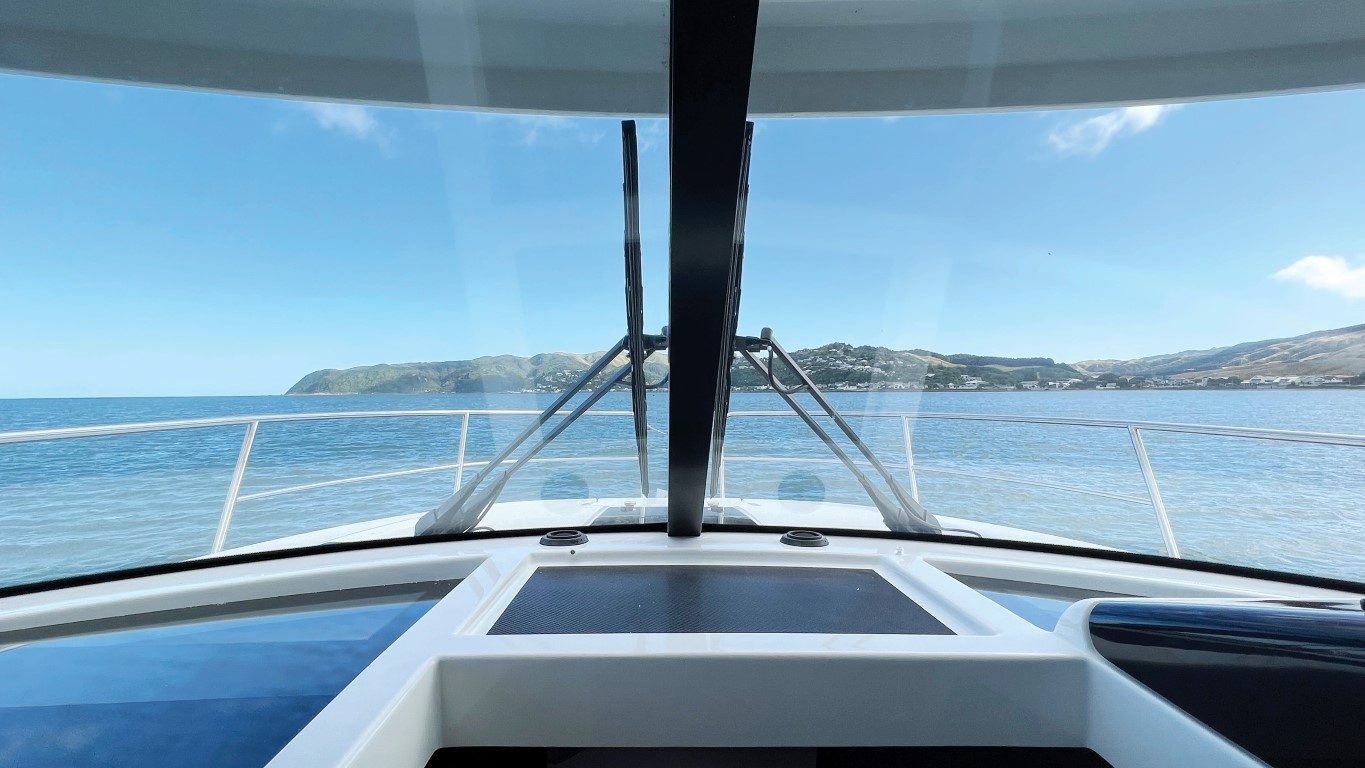
Outboards
A vital element of the ride was the outboard engine setup, which helps explain why this type of propulsion option is becoming so popular. The reasons behind this trend are straightforward, starting with performance. Outboard boats are fun! They accelerate fast, are lighter, more agile, and easier to drive and dock.
Outboards are also easier to repair, maintain, and replace if required – and they make available much more usable space inside the boat, otherwise occupied by inboard engines. They also require less draft, so they can operate safely in shallower water. As a boat owner, you no longer need to worry about through-hull fittings, shafts, struts and bearings.
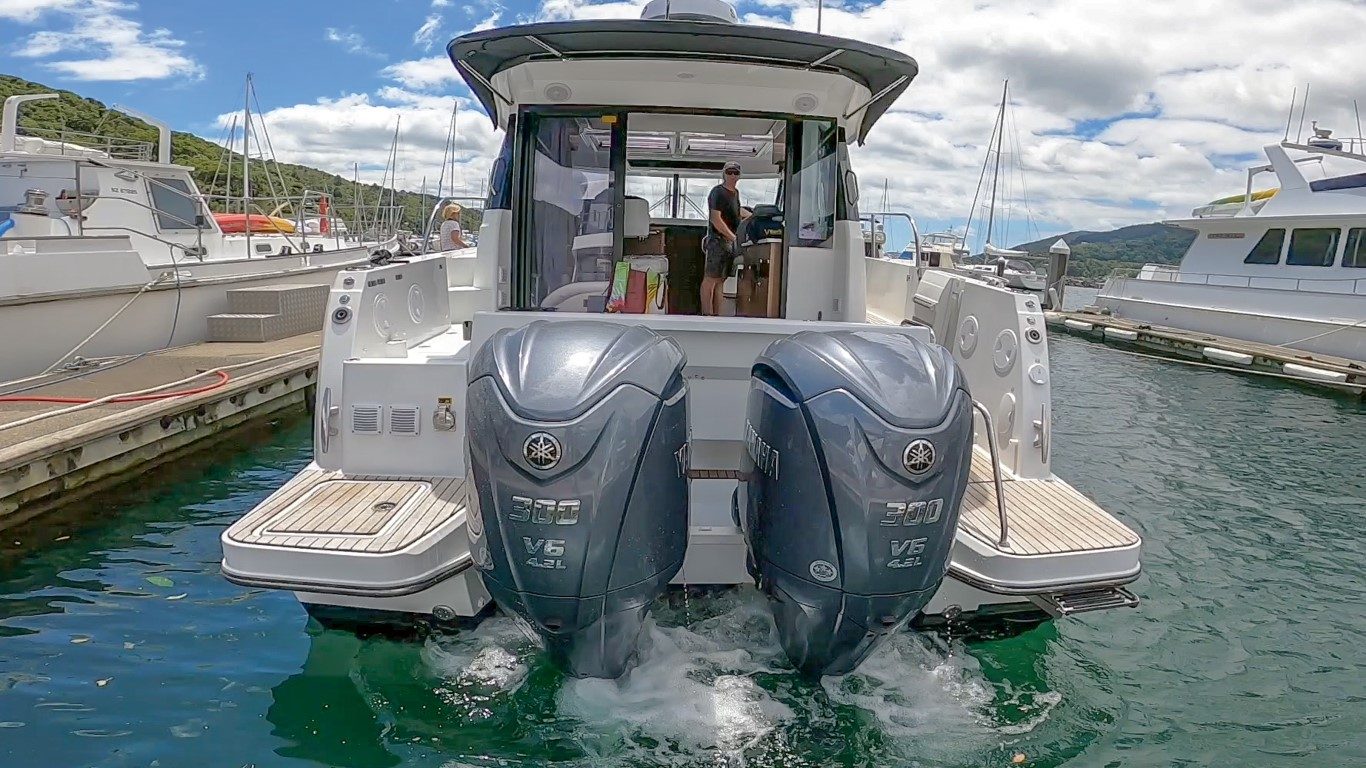
The Jeanneau Merry Fisher 1095 is available in two different configurations. The first is like our test boat, a sedan with a sunroof, and the second has an open-air flybridge. This edition of the 1095 has a pair of Yamaha F300hp V6 4.2-litre outboards, combined with the Yamaha Helm Master EX joystick controls.
These outboards incorporate the latest technological advancements previously only seen on Yamaha’s flagship V8 425hp XTO. They come with Yamaha’s new Thrust Enhancing Reverse Exhaust system, which according to the manufacturer, delivers increased prop grip and thrust for improved acceleration, manoeuvring in docking situations, and reversing up to your next big catch. We had no way of testing the impacts of this sort of technology on test day, but the big Yamahas certainly punched the Jeanneau Merry Fisher 1095 out of the hole with a level of acceleration generally reserved for sport boats, not cruisers.

The joystick control was excellent, and for the most part, the bow thruster was superfluous when docking or just manoeuvring at low speeds – no need for inboards with more expensive IPS Pod Drives. This setup will appeal to many and make single-handed boating a reality for more people.
The owners of this Jeanneau Merry Fisher 1095 are downsizing from a large well-known, branded sportfisher because they want to reduce the costs of clocking up the miles, servicing, and berthage. But they didn’t want to give up any boating comforts or usable space. As keen fishers and experienced scuba divers, they knew what they were looking for in their new boat.
Space everywhere
The Jeanneau Merry Fisher 1095 is a cruising boat with enough interior space for two couples or a family. The forward cabin has an island berth that sleeps two adults comfortably, and the cabin has a head with a shower. The port cabin contains a double bed, and the starboard cabin has two single berths. Both are private spaces with easy access to shared head and shower facilities.
When underway, the saloon has a passenger seat with a hinged backrest that can cater to two adults. The seat back can be reversed so that the seat addresses the dining table, which can be lowered to create another adult-sized double berth. Including the saloon, the vessel’s sleeping capacity is up to eight adults.
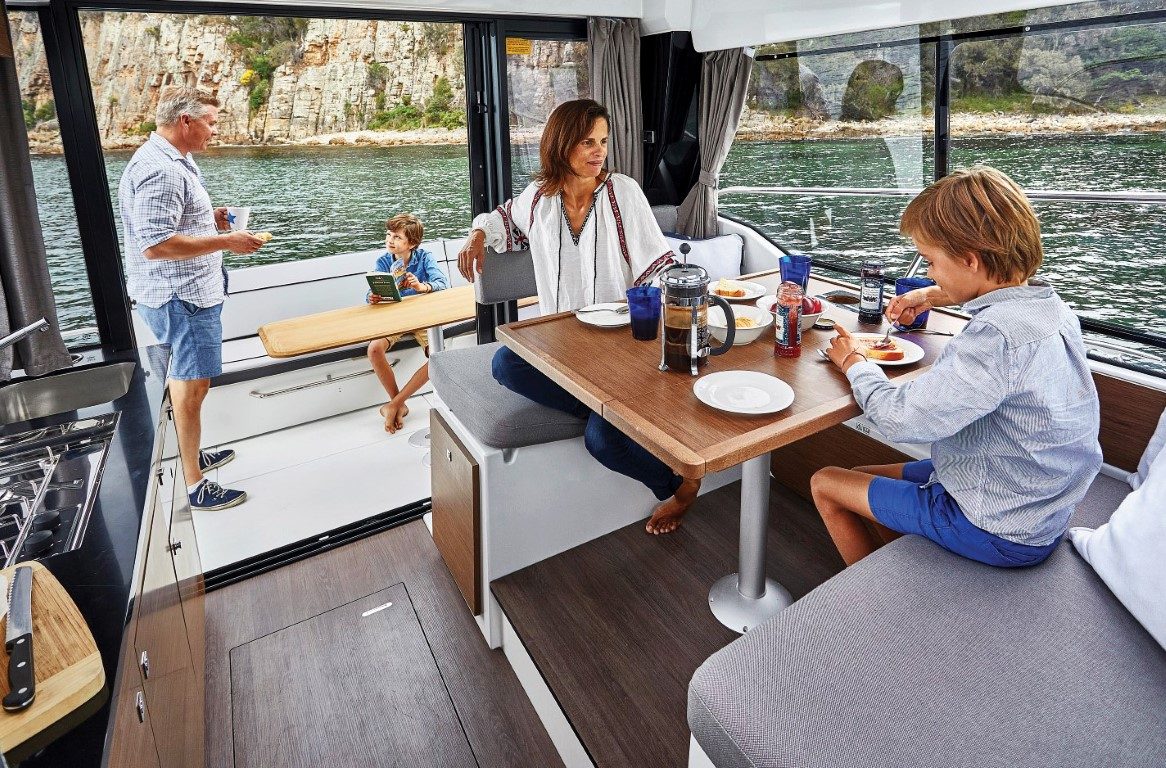
The saloon can be completely enclosed, has a sunroof, and there’s a good-sized sunlounger outside making the most of the vessel’s 3.37m beam. The standard galley includes a sink, fridge, inverter, microwave and combination gas stove/oven.
Helming is comfortable while seated on the smart captain’s chair. This seat is supportive whether seated or using a lean-to-driving positions. The test boat was fitted with the latest Simrad touchscreen multi-function display, with an additional display screen for the Yamaha autopilot and engine gauges.
A recessed walk-around side deck runs along both sides of the cabin, leading to the foredeck and sun lounger. A sliding side door next to the helm station means the skipper can quickly exit to get to the bow if necessary and is an excellent feature when berthing short-handed or with a less experienced crew.

The saloon’s wide sliding doors aft open out into the cockpit, which is on the same level. The transom seat slides fore and aft depending on need – it must be slid forward all the way to allow the engines to be trimmed up out of the water.
Cockpit seats provide good seating capacity and a lot of handy storage underneath them. In the test boat, an electric reel connection has been installed. The connection is discreet and sealed against water ingress when not in use. Fishing rod holders are located all around the boat’s stern area.
Marlborough Sounds
As we crossed Cook Strait, we entered the Marlborough Sounds via the northern passage between Endeavor Inlet and Arapaoa Island, where we found some calm water, ate lunch, and admired the beautiful scenery.
Refreshed and rested, it was time to speed test. The top speed we achieved on test day was 37.9 knots at 5600rpm. With some running in and hull pitch tuning, this boat will likely achieve a top speed of 40 knots. That’s good for a 4680kg (dry) cruising boat offering this much space and volume. I hadn’t expected the boat to feel like it loved speed and cornering as much as it did.
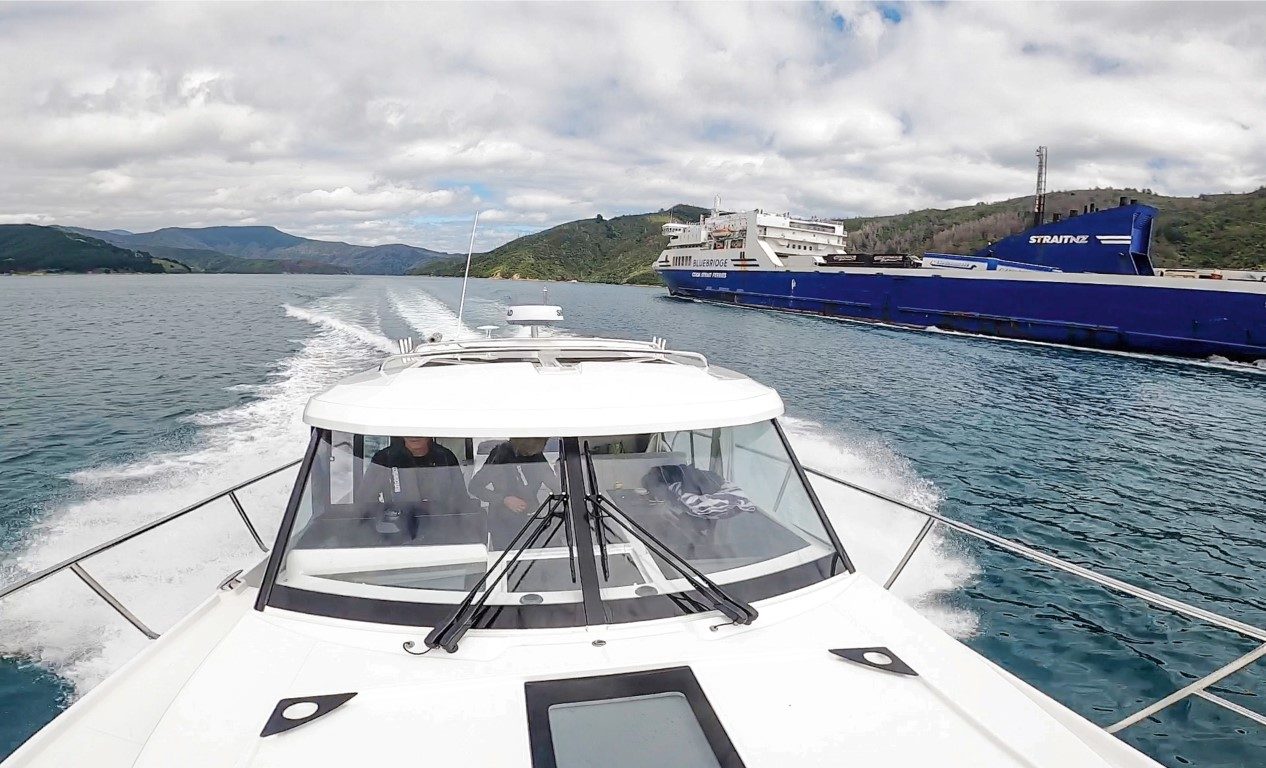
At 26.8 knots, the fuel burn rate was 51 litres per hour per engine. With twin 400-litre tanks, the boat has a range of over 200 nautical mailes at this speed – way more than most boaties would use in a long weekend. A week of cruising on a single fill of fuel is very cost-effective boating, and when combined with the 260-litre freshwater capacity, the Merry Fisher should be very comfortable too.
Owners of a Jeanneau Merry Fisher 1095 can readily upgrade and add various elements to the boat. The colour and fabric used for the furnishings, sunshades and awnings, additional overhead lockers, and the type and style of flooring and decking are all customisable. Air conditioning or diesel heating options are possible, as is specifying a genset or a larger bank of house batteries to provide more amp hours.

The test boat was fitted with CHIRP and DownScan technology, which was impressive at low speeds, but the new owner plans to improve visibility through the water column at higher speeds by installing a 2kW through-hull transducer.
This amount of liveable space is only possible because of the Merry Fisher’s engine setup. The boat is easy to walk around and walk through. It has a clean and uncluttered layout with full head height throughout.
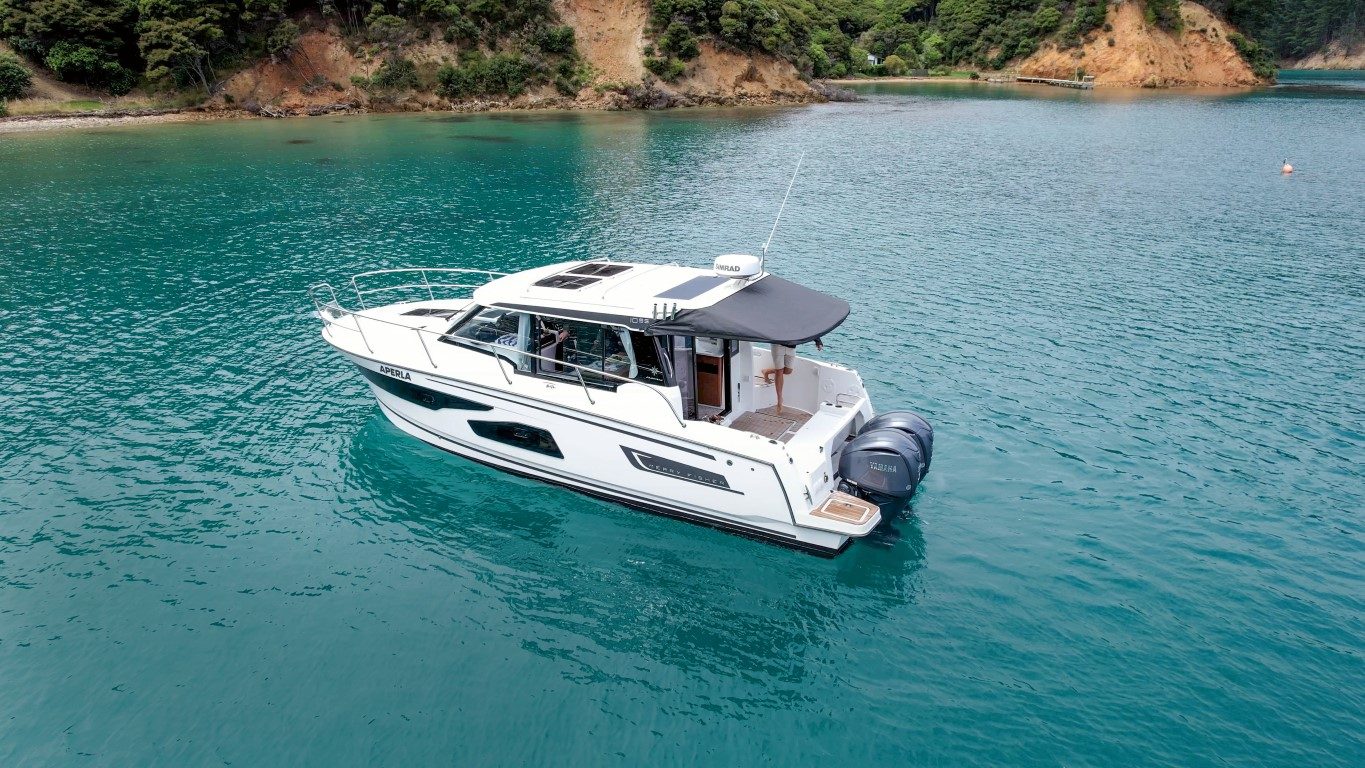
Based in France, the team at Jeanneau has been designing and building motorboats since the late 1950s. With this model, they have created a set of design principles that deliver an enormous amount of space for a vessel of its size, without sacrificing hull performance. The boat’s maiden voyage was impressive – a testament to how well put together this package really is.
The Merry Fisher 1095 should prove to be a most cost-effective vessel to run and own, while at the same time delivering plenty of fun. I predict the trend towards outboards will only grow – the boat reviewed here shows us why.
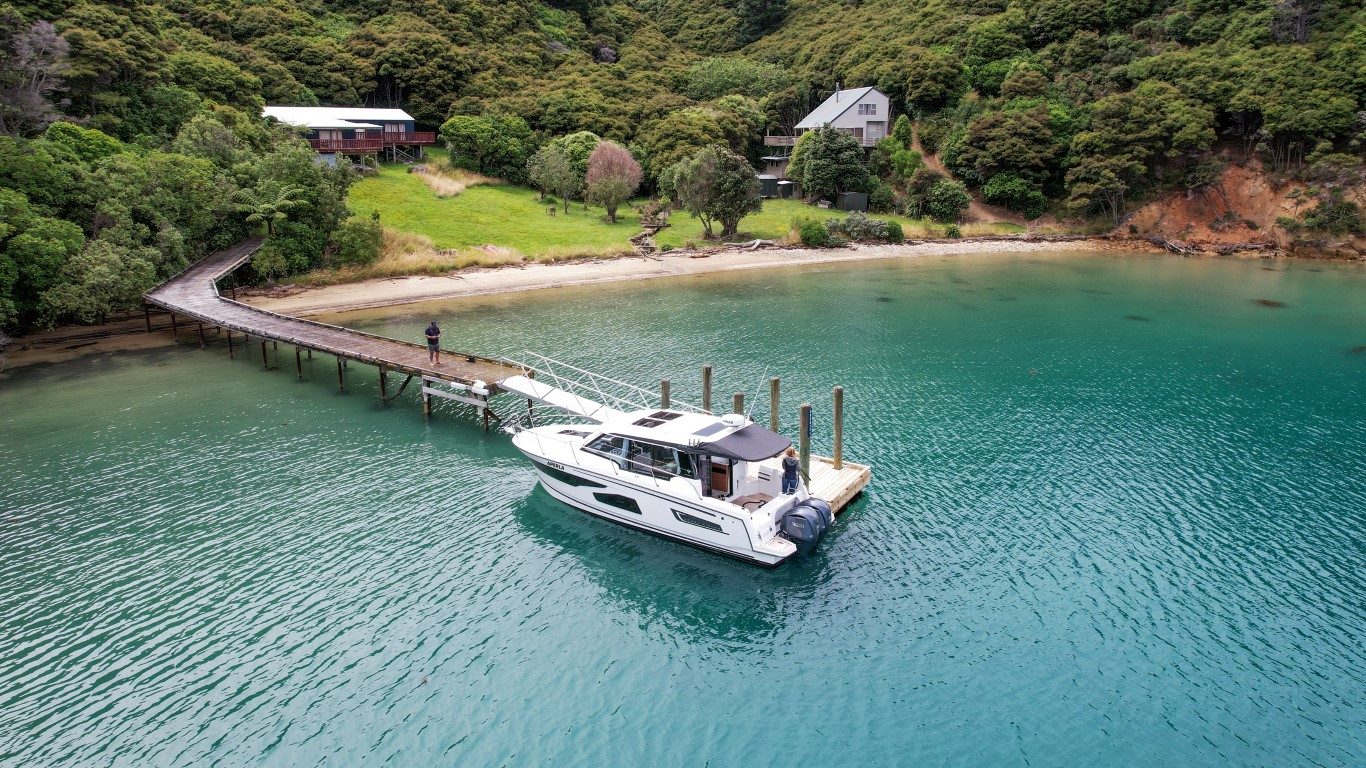
/>
‘Behemoth’ is a word which springs to mind or, perhaps more nautically, ‘leviathan’.
White Pointer has earned the respect of discerning customers in New Zealand and Australia, attracting a loyal and ever growing following for its high-quality, rugged and totally dependable aluminium trailer boats.
The hardtop SP635 shares the same underpinnings as the popular SF 635 which was a completely new model back in 2020.
The pride and joy of a multi-generational family, Bliss resides on a pier that’s home to a couple of other Elite motor launches – Sandspit Marina is a hot-spot for the Bill Upfold-designed vessels, with several calling this small marina home.